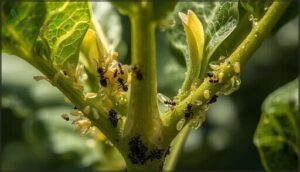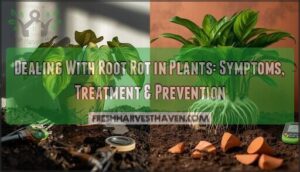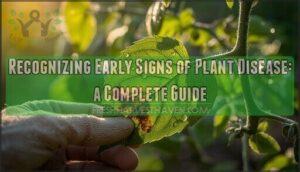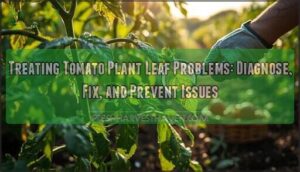This site is supported by our readers. We may earn a commission, at no cost to you, if you purchase through links.
When aphids multiply unchecked, they can transform a thriving garden into a battleground of curled leaves, sticky residue, and weakened plants. These tiny pests reproduce at alarming speeds, with a single female birthing up to 80 offspring in her lifetime.
The good news? You don’t need synthetic chemicals to win this fight. Organic solutions for aphids work with nature’s design rather than against it, using everything from predatory insects to simple soap sprays.
By understanding how these soft-bodied invaders operate and deploying the right natural defenses, you can protect your plants while maintaining a healthy ecosystem that keeps aphids from staging a comeback.
Table Of Contents
- Key Takeaways
- Identifying and Understanding Aphid Infestations
- Natural Methods to Remove Aphids
- Beneficial Insects for Aphid Control
- Companion Planting and Prevention Strategies
- Top 6 Organic Products for Aphid Control
- Frequently Asked Questions (FAQs)
- How to control aphids naturally?
- What aphid control options are organic?
- How do I get rid of aphids in my garden?
- Do vinegar sprays keep aphids away?
- What plants repel aphids?
- How do you get rid of aphids with garlic?
- What is the best organic remedy for aphids?
- Do banana peels really work for killing aphids?
- Does vinegar kill aphids naturally?
- What are some organic aphid control options?
- Conclusion
Key Takeaways
- You can control aphids effectively using natural methods like hand-squishing, water sprays, garlic or tomato leaf sprays, and soapy water solutions.
- Beneficial insects such as ladybugs and green lacewings are powerful allies that hunt aphids and help keep your garden balanced without chemicals.
- Companion planting with herbs like basil, chives, and marigolds, along with trap crops and bird-friendly habitats, creates natural barriers that prevent aphid infestations.
- Organic products like castile soap, neem oil, insecticidal soap, live ladybugs, lacewing eggs, and nematodes offer safe, proven options for managing aphids while protecting beneficial insects.
Identifying and Understanding Aphid Infestations
Before you can tackle an aphid problem, you need to know what you’re looking for. These tiny pests leave behind telltale signs that can help you catch an infestation early, before it spirals out of control.
Let’s walk through how to spot aphid damage, what these insects actually look like, and which plants in your garden are most at risk.
Common Signs of Aphid Damage
Leaf deformation is often your first clue that aphids have moved in. You’ll notice curling, twisting, or yellowing leaves, especially on tender new growth.
Look for honeydew, a sticky film coating stems and leaves, which attracts ants and encourages black sooty mold. Check undersides of leaves for clusters of tiny bugs or shed skins—clear aphid evidence signaling an active infestation affecting your plant health.
In most cases, aphids cause little or no damage to plant health.
Aphid Appearance and Life Cycle
Once you recognize the damage, identifying the culprit helps you act faster. Aphids are pear-shaped, soft-bodied insects, usually 1–4 mm long, appearing in green, yellow, brown, black, or red.
Their lifecycle stages progress rapidly:
- Egg: Overwintering stage in many species
- Nymph: Resembles smaller adults, molts four times
- Adult: Winged or wingless, reproducing asexually in warm months
- Sexual generation: Produces overwintering eggs in fall
Temperature and humidity accelerate reproduction methods, with females birthing up to 80 offspring. Understanding aphid life cycles is essential for effective management and control.
Plants Most Vulnerable to Aphids
Knowing which species target your plants helps you stay ahead of aphid damage before it spirals. Green peach, potato, melon, and cabbage aphids plague many vegetables, while rosy apple and woolly apple aphids attack fruit trees. Ornamentals like roses and chrysanthemums face their own specialized species, and legumes suffer significant yield losses from pea aphids.
Early season aphid infestation on young plants can slash production by 30%, especially in lentils and peas. That’s why understanding plant susceptibility gives you the upper hand in crop protection and natural aphid control methods. Certain biochemical traits and leaf surfaces influence how badly aphids hit your garden, shaping your organic pest control strategy from the start.
| Vulnerable Crops | Common Aphid Species | Key Aphid Damage |
|---|---|---|
| Beans, cabbage, tomato, pepper | Green peach, potato, melon, cabbage aphid | Leaf curling, stunted growth, virus transmission |
| Apples, soft fruits | Rosy apple, woolly apple aphid | Deformed fruit, sooty mold, reduced photosynthesis |
| Roses, chrysanthemums, ornamentals | Rose, oleander, root aphids | Yellowing leaves, reduced aesthetic value |
Natural Methods to Remove Aphids
When aphids take over your garden, you don’t need harsh chemicals to fight back. Several straightforward, organic methods can knock down aphid populations quickly and safely.
Here’s how to remove these pests using techniques that work with nature, not against it.
Hand-Squishing and Pruning Techniques
When you’re dealing with a small aphid infestation, manual control through hand-squishing and pruning methods offers immediate relief. Simply pinch soft-bodied aphids between your fingers or snip off heavily infested tips to remove entire colonies before they spread.
These organic pest control gardening techniques can slash aphid populations by up to 90%, giving you real control over garden maintenance without chemicals disrupting your natural aphid control methods.
Dislodging Aphids With Water Sprays
A strong blast from your garden hose knocks aphids off plants without harming beneficial insects like ladybugs. This organic control method cuts aphid coverage by 50% to 100% in a single session, though you’ll need repeated treatments since these pests can recolonize within days.
You’ll need to spray three times weekly, focusing that water pressure on rose buds, beans, and cabbage where aphids cluster.
DIY Garlic and Tomato Leaf Sprays
You can utilize the aphicidal power of garlic spray and tomato leaf extract as homemade sprays that disrupt aphid feeding behavior. These natural insecticides and DIY bug spray options provide organic pest control while protecting beneficial insects in your garden ecosystem.
Blend one garlic head with water, steep overnight, strain, then add soap to help it stick. Tomato leaf spray works similarly—steep leaves, strain, and dilute before application.
Using Soapy Water Solutions Safely
Soap spray offers effective natural pest control when you follow these aphid control methods carefully. Mix 1-2 teaspoons of liquid soap per pint of water for proper soap concentration, ensuring safe insecticidal soap strength.
Apply with these spray techniques:
- Test on a small leaf area for plant sensitivity before full application
- Spray undersides of leaves thoroughly during cooler morning hours
- Repeat application frequency every 5-7 days as needed
- Avoid excessive use to minimize ecological impact on beneficial insects
Beneficial Insects for Aphid Control
You don’t have to fight aphids alone—nature provides some of the most effective pest control available. Beneficial insects work around the clock to hunt down aphids, often eliminating entire colonies without any chemicals or constant intervention from you.
Let’s look at which insects deliver the best results and how to bring them into your garden successfully.
Ladybugs and Their Role in Aphid Management
Ladybugs are nature’s aphid-eating machines, with a single adult consuming up to 50 aphids daily and larvae devouring as many as 400 before maturing.
These beneficial insects offer powerful biological control as part of integrated pest management. For effective natural pest control, release about 1,500 ladybugs per 100 square feet at dusk, ensuring plants are watered first to improve retention and aphid predation success.
| Ladybug Stage | Aphid Consumption Rate |
|---|---|
| Adult Ladybug | Up to 50 aphids per day |
| Larva | Up to 400 aphids total |
| Lifetime | Up to 5,000 aphids |
Green Lacewings and Other Natural Predators
Green lacewings offer fierce biological control, with larvae devouring up to 50 aphids daily during their 2-4 week feeding stage. These beneficial insects work alongside other natural predators to suppress infestations without chemicals, giving you the freedom to grow organically while protecting your ecosystem.
- Green lacewing larvae: Each consumes 200+ pests weekly, targeting aphids with paralyzing venom
- Hoverfly and parasitic wasp allies: Attack aphids from multiple angles, strengthening your garden’s defenses
- Birds like goldfinches: Feast on aphids naturally, with some consuming them as 83% of their diet
Releasing Beneficial Insects in Your Garden
Release beneficial insects at twilight to boost survival and establishment. You can buy ladybugs, green lacewings, or Aphidius colemani from suppliers, but success depends on timing and garden habitat creation.
Stage releases over several weeks during early infestations, avoid spraying soaps beforehand, and control ants that protect aphids.
Integrated pest strategies combining biological control methods with habitat enrichment guarantee these predators stay and multiply naturally.
Companion Planting and Prevention Strategies
Preventing aphids before they take hold is always easier than fighting an active infestation. By choosing the right plants and maintaining a balanced garden environment, you can create natural barriers that keep aphid populations in check.
Here are four proven strategies that work with nature instead of against it.
Aphid-Repelling Plants and Herbs
Certain herbs and flowers work like natural aphid repellent through their plant volatiles and essential oils. You can build an herb garden featuring basil, chives, and garlic alongside marigolds to create a protective barrier using botanical extracts that disrupt aphid host recognition.
Companion planting with aromatic species attracts lacewings and beneficial insects while making your garden less hospitable to these sap-sucking pests.
Trap Crops for Aphid Diversion
While companion planting repels aphids, trap crops draw them away from your prized vegetables. Plant nasturtiums, mustard, or marigolds around your garden’s border to intercept aphids before they reach your main harvest.
Here’s how to optimize pest diversion:
- Plant trap crops 1-2 weeks early to establish aphid attraction before your vegetables emerge
- Position borders strategically using marigolds and radishes at garden entry points
- Destroy infested trap plants once aphids saturate them, preventing migration back to your crops
Reducing Over-Fertilization and Garden Debris
Beyond barriers and traps, your fertilizer habits shape aphid populations. Excessive nitrogen creates a feeding paradise—studies show nitrogen-rich plants experience considerably higher aphid infestations because the enriched sap boosts their reproduction.
Switch to slow-release organic fertilizers to maintain soil health and plant resistance.
Clear garden debris regularly, as accumulated waste shelters overwintering aphids and disrupts predator habitats, undermining your organic gardening and pest management efforts.
Attracting Birds and Other Natural Allies
Just as healthy soil repels pests, a well-designed bird habitat brings powerful aphid control. Chickadees can devour thousands of aphids daily, and integrating beneficial insects like ladybugs with these natural allies creates predator diversity that strengthens your garden’s ecological balance.
The landscape context matters—hedgerows and wildflower strips boost natural pest management while delivering economic benefits through reduced spray costs.
Create Your Bird-Friendly Aphid Defense:
- Plant native shrubs and flowering perennials that provide year-round shelter and nesting sites for insectivorous birds.
- Install shallow water sources near vulnerable plants to increase bird visitation frequency during peak aphid season.
- Add hedgerows with mixed heights to attract diverse predator species that target aphids at different life stages.
Top 6 Organic Products for Aphid Control
If you prefer ready-to-use solutions over DIY sprays, several organic products can simplify your aphid control efforts. These options range from gentle soaps to beneficial insects you can release directly into your garden.
Here are six effective products that align with organic gardening principles and deliver real results.
1. Pure Organic Castile Liquid Soap
If you’re looking for a simple, effective organic pesticide against aphids, liquid castile soap should be your first stop. This biodegradable liquid soap works by breaking down the protective coating on aphids, causing them to dehydrate.
Mix about 1 to 2 tablespoons of pure castile soap per quart of water to create your aphid spray—that’s roughly a 1-2% soap concentration. Spray directly onto infested areas, targeting the undersides of leaves where aphids hide.
You’ll need to reapply every few days since insecticidal soap only kills on contact, not preventing future infestations.
2. Organic Insect Killing Garden Soap
For serious aphid problems, commercial organic insect-killing garden soap delivers powerful results you can count on. These ready-to-use formulations contain potassium salts of fatty acids as their active ingredient, achieving up to 95% reduction in aphid populations within 48 hours through insecticidal action.
Soap efficacy depends on direct contact, as it disrupts cellular membranes and removes protective waxes.
Most garden safety-focused products are OMRI-listed for organic pest management, causing minimal environmental impact while protecting beneficial insects when applied correctly.
3. Natural Neem Oil Insect Spray
Neem oil stands out among eco-friendly alternatives, offering proven organic pest management backed by its active compound, azadirachtin. This natural insect spray delivers 60% to 85% aphid reduction within seven days through spray application that disrupts feeding, molting, and reproduction.
You’ll need two treatments spaced ten days apart for maximum control, as neem residues break down quickly in sunlight. The formula complements natural gardening techniques by preserving beneficial insects when applied during early morning or evening hours, making it safer than homemade sprays or essential oil spray blends.
4. Live Ladybug Pest Control Solution
Live ladybugs deliver impressive organic pest control power, with adults consuming up to 50 aphids daily and reducing infestations by 50% to 93% within days. These beneficial insects work as biocontrol methods in integrated pest management strategies, though you’ll need proper ladybug care for success.
Store them refrigerated, then release small batches at dusk near aphid hotspots. Follow ladybug release tips like misting plants beforehand to improve retention, since 95% naturally disperse within 48 hours.
Despite their wandering nature, ladybug efficacy rates make them valuable natural control allies.
5. Green Lacewing Pest Control Eggs
Green lacewings offer some of the most impressive aphid control among beneficial insects, with each larva devouring up to 50 aphids daily during peak feeding. You can release these biological control allies at 5,000 to 50,000 eggs per acre, depending on infestation severity.
Hatch rate factors like temperature and shipping conditions affect success, generally ranging from 64% to 92%. While larval predation rates shine in pest control trials, cost-benefit analysis shows drone or hand release runs $176-$185 per hectare.
The environmental impact remains minimal, preserving pollinators while crushing aphid populations.
6. Natural Pest Control Nematodes Spray
Beneficial nematodes target root aphids and soil-dwelling pests where other biological control methods can’t reach. You’ll apply Steinernema feltiae at roughly 229.6 million nematodes per 10,000 square feet, mixed with water and sprayed under high humidity conditions. Nematode efficacy hits 90% mortality in ideal settings, though application methods demand careful timing and moisture.
While market adoption grows with regulatory approval across North America and Europe, environmental impact remains negligible compared to chemical alternatives. This organic pest control technique complements beneficial insects in complete pest management for gardens.
Frequently Asked Questions (FAQs)
How to control aphids naturally?
You can control aphids naturally using water sprays, organic pesticides like neem oil and essential oils, soapy water solutions, natural repellents, companion plants, and predator introduction through beneficial insects—all without harmful chemicals in your garden.
What aphid control options are organic?
Nature offers you a full arsenal against aphids—from insecticidal soaps and neem oil sprays to predatory ladybugs, companion plants like marigolds, and simple water jets that dislodge pests without chemicals.
How do I get rid of aphids in my garden?
You can knock aphids off with water sprays, apply organic sprays like neem oil for pest control, hand-pick them, or release ladybugs.
Preventing aphid returns requires consistent monitoring and organic gardening practices.
Do vinegar sprays keep aphids away?
You’ve likely noticed aphids thriving just when your garden hits its stride.
Vinegar sprays kill aphids on contact through acidic dehydration, but they can burn leaves if misapplied, requiring careful dilution and timing for safe organic pest control.
What plants repel aphids?
You can plant aromatic herbs like rosemary, which greatly reduces aphid populations, plus marigolds, peppers, garlic, and flowering plants such as buckwheat.
These companion planting strategies disrupt aphid settlement through essential oil efficacy and natural deterrent activity.
How do you get rid of aphids with garlic?
Crush 4–5 garlic cloves, mix with soapy water, strain, and dilute for a homemade garlic spray recipe.
Apply twice weekly for effective aphid garden pest control.
Garlic’s effectiveness is high, but watch for non-target impacts.
What is the best organic remedy for aphids?
Think of aphids as stubborn guests at a garden party—neem oil stands out for its efficacy, cost efficiency, and minimal environmental impact.
Application is simple, long-term effects are strong, and it complements other organic pest control techniques beautifully.
Do banana peels really work for killing aphids?
Banana peels don’t kill aphids outright, but Ethylene as Repellent disrupts feeding. Soil Health Benefits may help plants resist aphids.
Limited Scientific Evidence exists, but Anecdotal Garden Reports suggest they’re best as Complementary Control Methods in Organic Gardening Techniques.
Does vinegar kill aphids naturally?
Like Odysseus facing many trials, vinegar efficacy against aphids is real—direct sprays can kill them, but application risks include phytotoxicity effects on leaves.
Compared to other organic pest control methods, evidence gaps remain for homemade insecticides and DIY bug spray longevity.
What are some organic aphid control options?
You’ve got several organic aphid control options: Castile soap sprays, Neem application for lasting results, biological controls like beneficial insects, plant-based repellents, and DIY sprays such as garlic or tomato leaf solutions—all gentle yet powerful.
Conclusion
Like a well-tuned orchestra, each organic solution for aphids plays its part in restoring harmony to your garden. When you combine observation, natural predators, and gentle sprays, you create a resilient system that keeps aphids from taking center stage.
Your plants thrive, and the ecosystem remains balanced. Trust that with these tools, you’re not just reacting—you’re shaping a healthier future for your garden. The difference is clear: nature’s methods don’t just solve problems; they help your space flourish.
- https://www.fantasticgardeners.co.uk/
- https://www.greenhousemegastore.com/?aff=2
- https://www.mcgill.ca/oss/article/did-you-know/farmer-ants-and-their-aphid-herds
- https://www.kqzyfj.com/click-8834312-13568685?url=https%3A%2F%2Fwww.vitacost.com%2Fdr-bronners-pure-castile-liquid-soap-baby-mild-unscented-2-fl-oz
- https://extension.usu.edu/pests/research/aphid-pests-on-vegetables










